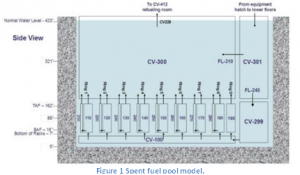MELCOR
MELCOR is a fully integrated, engineering-level computer code that models the progression of severe accidents in light water reactor nuclear power plants. MELCOR is being developed at Sandia National Laboratories for the U.S. Nuclear Regulatory Commission as a second-generation plant risk assessment tool and the successor to the Source Term Code Package. A broad spectrum of severe accident phenomena in both boiling and pressurized water reactors is treated in MELCOR in a unified framework. Current uses of MELCOR include estimation of severe accident source terms and their sensitivities and uncertainties in a variety of applications.
The MELCOR code is composed of an executive driver and a number of major modules, or packages, that together model the major systems of a reactor plant and their generally coupled interactions.
Reactor plant systems and their response to off-normal or accident conditions include:
- Thermal-hydraulic response of the primary reactor coolant system, the reactor cavity, the containment, and the confinement buildings.
- Core uncovering (loss of coolant), fuel heatup, cladding oxidation, fuel degradation (loss of rod geometry), and core material melting and relocation.
- Heatup of reactor vessel lower head from relocated fuel materials and the thermal and mechanical loading and failure of the vessel lower head, and transfer of core materials to the reactor vessel cavity.
- Core-concrete attack and ensuing aerosol generation.
- In-vessel and ex-vessel hydrogen production, transport, and combustion.
- Fission product release (aerosol and vapor), transport, and deposition.
- Behavior of radioactive aerosols in the reactor containment building, including scrubbing in water pools, and aerosol mechanics in the containment atmosphere such as particle agglomeration and gravitational settling.
- Impact of engineered safety features on thermal-hydraulic and radionuclide behavior.
Users: Eleonora Skrzypek, Maciej Skrzypek




